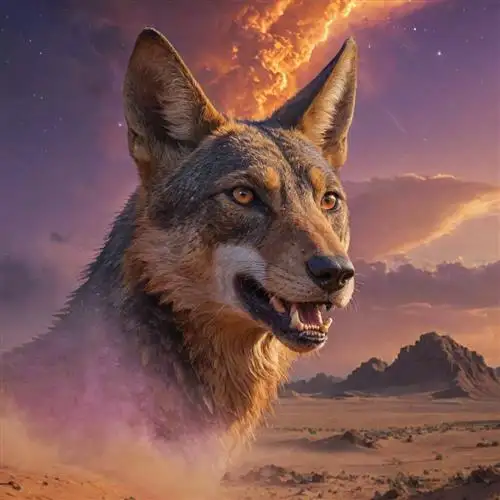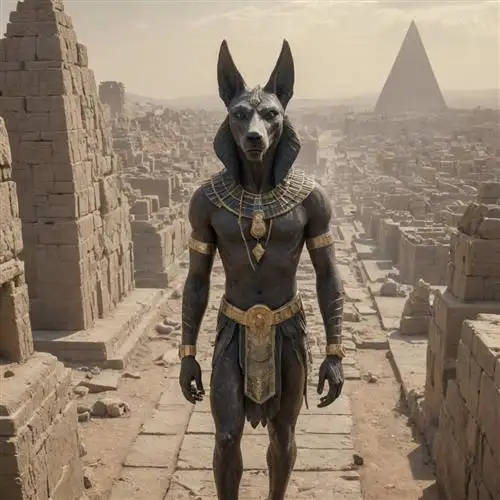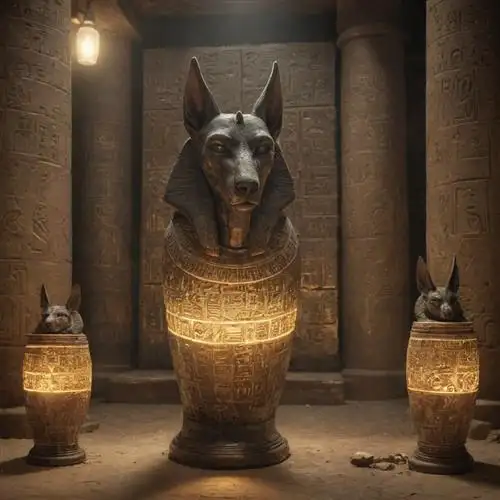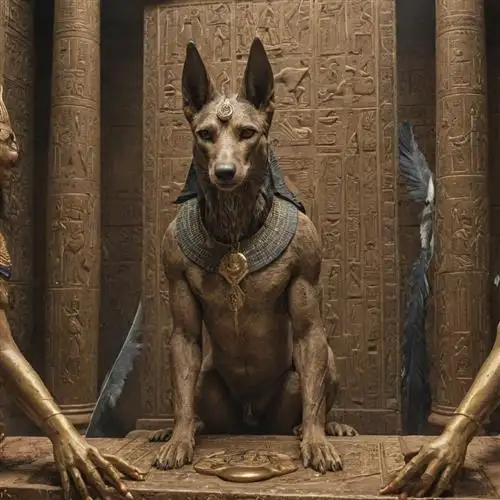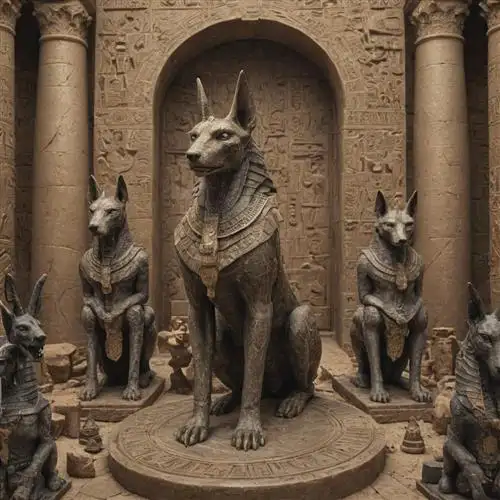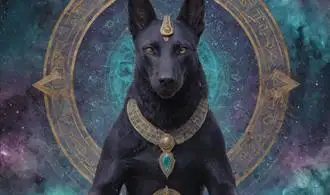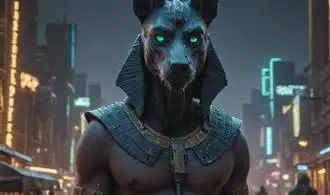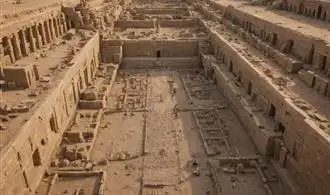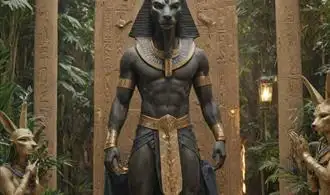
The Jackal Head of Anubis
Anubis, the ancient Egyptian god of the dead, is closely associated with the jackal-headed imagery that has captivated the imagination of scholars and the public alike. This distinctive feature of Anubis' iconography holds profound significance, reflecting the complex symbolism and multifaceted role of this important deity in the ancient Egyptian pantheon.
The jackal, or more specifically, the Egyptian jackal (Canis aureus lupaster), was a common sight in the arid landscapes of ancient Egypt. These scavengers were often observed prowling around cemeteries and graveyards, feeding on the remains of the deceased. This association with the realm of the dead led the ancient Egyptians to identify the jackal as a powerful symbol of the funerary process and the transition from life to the afterlife.
Anubis' jackal-headed form is believed to symbolize his role as the guardian of the necropolis and the protector of the dead. The jackal's keen senses, ability to navigate the darkness, and connection to the underworld made it an ideal representation of Anubis, who was responsible for embalming the deceased, guiding the dead through the afterlife, and overseeing the process of mummification.
In addition to the jackal-headed depiction, Anubis was also sometimes represented as a full jackal or a hybrid creature with the body of a human and the head of a jackal. These variations in iconography likely reflected the diverse aspects of Anubis' multifaceted role, which encompassed not only the funerary rituals but also the broader realm of the afterlife and the protection of the deceased.
The significance of the jackal-headed Anubis is further reinforced by the deity's association with specific funerary rituals and symbols. For instance, Anubis was often depicted as standing guard over the canopic jars that contained the embalmed organs of the deceased, ensuring their safe passage into the afterlife. Additionally, the jackal-headed Anubis was sometimes shown performing the ritual of "Opening the Mouth," a crucial ceremony that was believed to restore the deceased's ability to speak, breathe, and partake in the offerings presented in the afterlife.
Anubis Guarding the Dead
Anubis, the jackal-headed Egyptian god, was revered as the protector and guardian of the dead. His unwavering presence at the heart of ancient Egyptian funerary rituals and beliefs is a testament to the profound significance he held in the afterlife. As the deity responsible for the embalming process and the conductor of the weighing of the heart ceremony, Anubis played a critical role in ensuring the safe passage of the deceased into the realm of the dead.
One of the most iconic and recognizable aspects of Anubis' imagery is his depiction as a jackal or a man with a jackal head. This symbolic representation is believed to be rooted in the jackal's natural behavior and habitat, as these animals were often seen scavenging and prowling around ancient Egyptian necropolises and cemeteries. Anubis' association with the jackal, a creature that traversed the boundaries between the living and the dead, solidified his status as the gatekeeper and protector of the underworld.
In the embalming process, Anubis was responsible for overseeing the meticulous mummification of the deceased. This intricate ritual, which involved the removal of the internal organs, the desiccation of the body, and the wrapping in linen bandages, was essential for the preservation of the physical form. Anubis' presence during this crucial stage ensured the successful transition of the individual into the afterlife, where they would be reunited with their ka (life force) and ba (soul).
The weighing of the heart ceremony, known as the "Judgment of the Dead," was another pivotal moment in the Egyptian funerary rites where Anubis played a central role. During this ceremony, the deceased's heart was weighed against the feather of Ma'at, the goddess of truth and justice. If the heart was found to be pure and free from sin, the individual was granted passage into the afterlife. Anubis, as the conductor of this ritual, carefully observed the proceedings and ensured the fairness of the judgment.
Anubis' role as the guardian of the dead extended beyond the embalming and judgment processes. He was also believed to accompany the deceased on their journey through the underworld, providing protection and guidance to ensure a safe and successful passage. This belief was reinforced through the placement of Anubis statues and amulets within the tombs, serving as a physical embodiment of the god's presence and a source of comfort for the departed.
The Anubis Canopic Jars
The Anubis Canopic Jars hold a fascinating and integral role in ancient Egyptian funerary practices. These ornate vessels were used to store the internal organs of the deceased, each jar dedicated to a specific organ. Anubis, the jackal-headed god of embalming and the afterlife, was intimately associated with the canopic jars, overseeing their sacred purpose.
The four canopic jars typically included the jar for the stomach, the jar for the intestines, the jar for the liver, and the jar for the lungs. The heart was often left within the body, as it was believed to be the center of intelligence and emotion. The brain was removed and discarded, as the ancient Egyptians did not view it as an important organ.
The canopic jars were often elaborately decorated, with the lid of each jar depicting the head of one of the Four Sons of Horus. Imsety, the human-headed son, protected the liver. Hapy, the baboon-headed son, protected the lungs. Duamutef, the jackal-headed son, protected the stomach. Qebehsenuef, the falcon-headed son, protected the intestines. This symbolic representation reinforced the sacred purpose of the jars and the importance of preserving the organs for the afterlife.
The placement of the canopic jars within the tomb was also significant. They were often stored in a canopic shrine or chest, placed near the sarcophagus of the deceased. This proximity ensured the organs were protected and close to the mummified body, facilitating the deceased's transition to the afterlife. The The Fear of Failure with Anubis and the Afterlife explores the deeper spiritual and psychological significance of this process.
In some cases, the canopic jars were even adorned with the image of Anubis, further emphasizing his role as the guardian of the dead and the embalming process. This visual representation of the jackal-headed god served as a powerful symbol, inviting Anubis to watch over and protect the organs during the afterlife journey.
Anubis Weighing the Heart
The ancient Egyptian deity Anubis is renowned for his iconic role in the ritual of weighing the heart of the deceased against the feather of Ma'at, the goddess of truth and justice. This ceremonial act, known as the "Weighing of the Heart", held profound significance in the Egyptian afterlife beliefs. Let's explore some fascinating insights into this captivating aspect of Anubis imagery.
The Weighing of the Heart ceremony was a crucial step in the journey of the deceased towards the afterlife. During this ritual, the heart of the deceased was placed on one side of a scale, while the feather of Ma'at was placed on the other. If the heart was found to be lighter or equal in weight to the feather, it meant the individual had lived a righteous life, and their soul could proceed to the next phase of the afterlife. However, if the heart was heavier, it signified a life of sin, and the individual's soul would be consumed by the monstrous creature Ammit, a dreaded fate.
Anubis, the jackal-headed god, played a central role in this ceremony as the overseer of the weighing process. He was believed to have the power to tip the scales in favor of the deceased, provided they had lived a virtuous life. Anubis's presence ensured the accuracy and fairness of the weighing, as he was considered the patron of embalmers and the guardian of the dead.
The imagery associated with the Weighing of the Heart ceremony is both captivating and symbolically rich. Depictions often show Anubis standing beside the scales, carefully monitoring the process, while the deceased individual's heart and the feather of Ma'at are placed on the opposing pans. The presence of Anubis, with his distinctive jackal head, imbues the scene with a sense of solemnity and otherworldly significance.
The Weighing of the Heart ceremony was not just a physical act but also a metaphorical representation of the journey of the soul. The heart, seen as the seat of the individual's thoughts, emotions, and deeds, was the focus of this ritual. The feather of Ma'at, representing truth and justice, served as the standard against which the heart was judged, symbolizing the importance of living a life of virtue and moral integrity.
The Mummification Process and Anubis
Anubis, the jackal-headed Egyptian god, played a crucial role in the ancient Egyptian mummification process. As the god associated with embalming and the afterlife, Anubis oversaw the intricate and sacred rituals that transformed the deceased into a vessel for the soul's journey to the afterlife.
The mummification process was a meticulous and complex undertaking, with Anubis guiding each step along the way. After the death of an individual, the body would be brought to the "House of Embalming," where the priests, under the watchful gaze of Anubis, would begin the process of preserving the physical form.
The first step involved the removal of the internal organs, with the exception of the heart, which was believed to be the center of the soul. These organs were placed in canopic jars, each guarded by a different god, such as Imsety, Hapy, Duamutef, and Qebehsenuef. Anubis, as the god of embalming, would then oversee the desiccation of the body using natron, a naturally occurring salt, to remove all moisture from the tissues.
Once the body was sufficiently dried, Anubis would guide the priests in the wrapping of the deceased in linen bandages, a process that was both meticulous and symbolic. The linen strips were carefully layered and secured, with Anubis ensuring that the body was prepared for its journey to the afterlife.
After the mummification process was complete, the body would be placed in a sarcophagus, adorned with images and symbols of Anubis, the god who had ensured the preservation of the physical form. This was a critical step, as the mummy was now ready to be transported to its final resting place, where it would await the judgment of Osiris and the afterlife.
Anubis' role in the mummification process was not limited to the physical preparation of the body. The god was also responsible for guiding the soul of the deceased through the treacherous journey to the afterlife, protecting the mummy from harm and ensuring a successful transition to the next world.
Anubis Statues and Figurines
Anubis, the ancient Egyptian god of the dead, has been a captivating figure throughout history. One of the most striking representations of Anubis are the statues and figurines created by skilled artisans. These intricate works of art offer a glimpse into the reverence and significance of this powerful deity within the ancient Egyptian pantheon.
The craftsmanship and attention to detail in Anubis statues and figurines are truly remarkable. Many feature the distinctive jackal-headed figure, often depicted in a seated or standing pose, with the body of a human and the head of a canine. The attention to anatomical accuracy is impressive, capturing the distinct features of the jackal with precision.
A fascinating aspect of Anubis imagery is the symbolism and meaning behind the various poses and accoutrements. For example, Anubis statues may be shown holding the crook and flail, symbols of kingship and authority, indicating his role in the afterlife and the judgment of the dead. Other statues may depict Anubis in a more protective stance, suggesting his role as a guardian and protector of the deceased.
The materials used in the creation of Anubis statues and figurines also hold significant meaning. Bronze was a common medium, as it was believed to be a durable and long-lasting material. Precious metals like gold were also utilized, reflecting the importance and reverence accorded to the deity. Some Anubis figures were even crafted from a combination of materials, such as wood and bronze, further enhancing their visual impact.
The size and scale of Anubis statues also varied greatly, from small amulets and figurines to large-scale temple sculptures. These differences in size and scale often corresponded to the intended use and purpose of the artwork. Smaller figurines may have been used for personal devotion or placed within tombs, while the larger temple sculptures served to honor and venerate Anubis in a more public and grandiose manner.
Anubis in Modern Pop Culture
Anubis, the ancient Egyptian god of the dead, has maintained a strong presence in modern pop culture, captivating audiences worldwide. From film and television to art and fashion, this enigmatic deity has transcended the boundaries of ancient mythology, leaving an indelible mark on contemporary media and popular imagination.
One of the most notable examples of Anubis' impact on modern pop culture is his prominent feature in the blockbuster film "The Mummy" (1999) and its sequels. In this thrilling franchise, Anubis, portrayed as a powerful and menacing protector of the underworld, plays a central role in the narrative, adding an air of mysticism and supernatural intrigue to the story. The iconic image of Anubis, with his jackal-like head and imposing stature, has become synonymous with the "The Mummy" franchise, captivating audiences and solidifying the deity's place in contemporary cinema.
Furthermore, Anubis has found a home in the realm of television, with his likeness appearing in various shows and series. In the popular animated series "Stargate SG-1," Anubis is depicted as a powerful and cunning System Lord, showcasing the deity's adaptability and ability to transcend his ancient Egyptian origins. Similarly, in the supernatural drama "Sleepy Hollow," Anubis is featured as a mythical figure, blending seamlessly with the show's themes of the paranormal and the supernatural.
Beyond the silver screen, Anubis has also made significant inroads into the world of art and fashion. Contemporary artists have long been enamored with the enigmatic figure of Anubis, incorporating his likeness into their work to explore themes of mortality, the afterlife, and the human condition. In the fashion industry, Anubis-inspired designs have become increasingly prevalent, with high-end brands and independent designers alike drawing inspiration from the deity's iconic imagery to create striking and visually captivating pieces.

